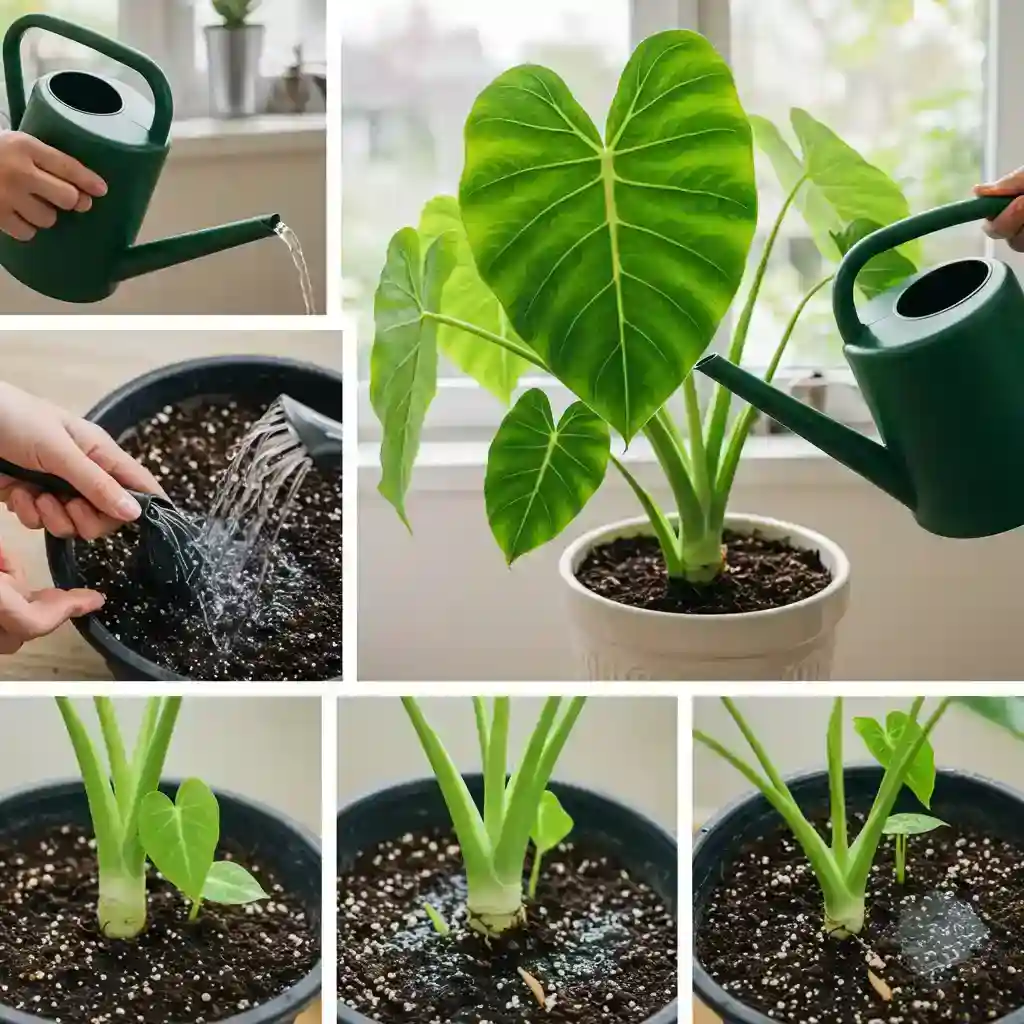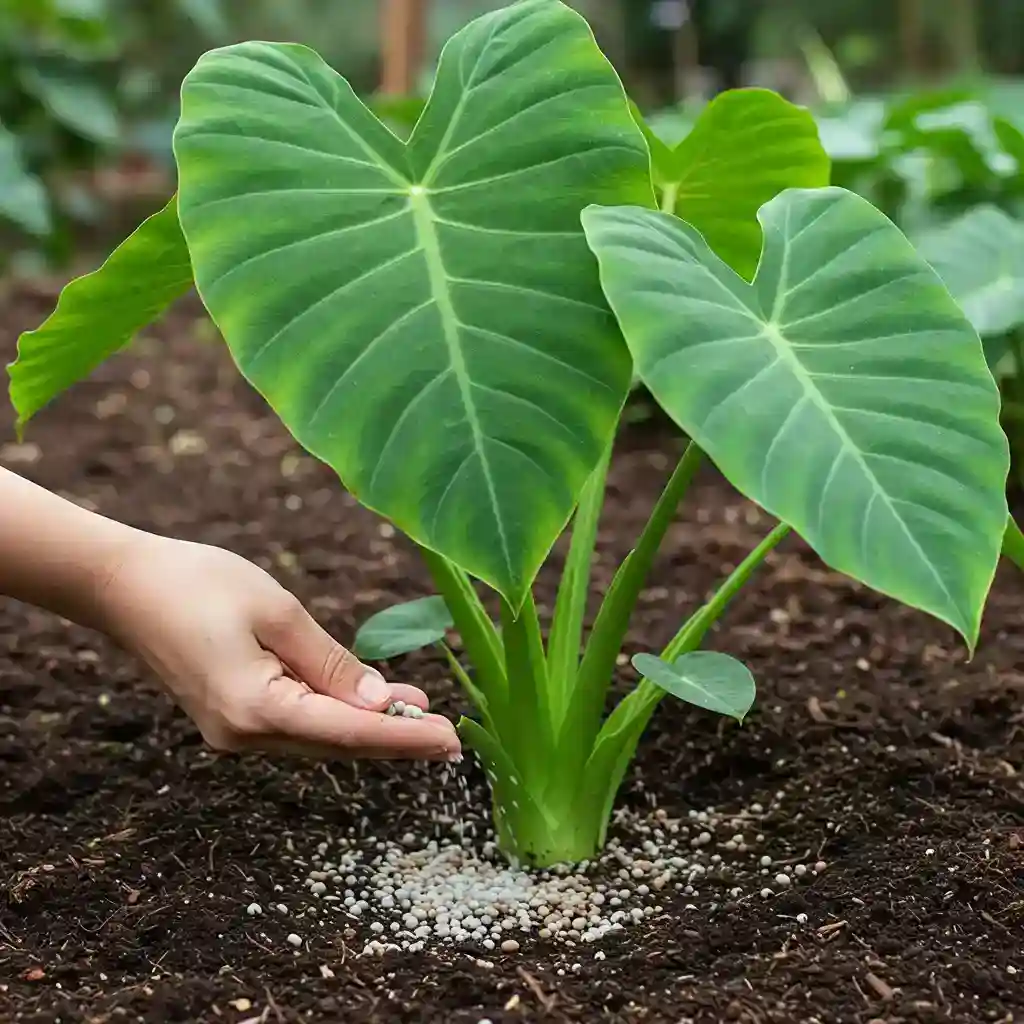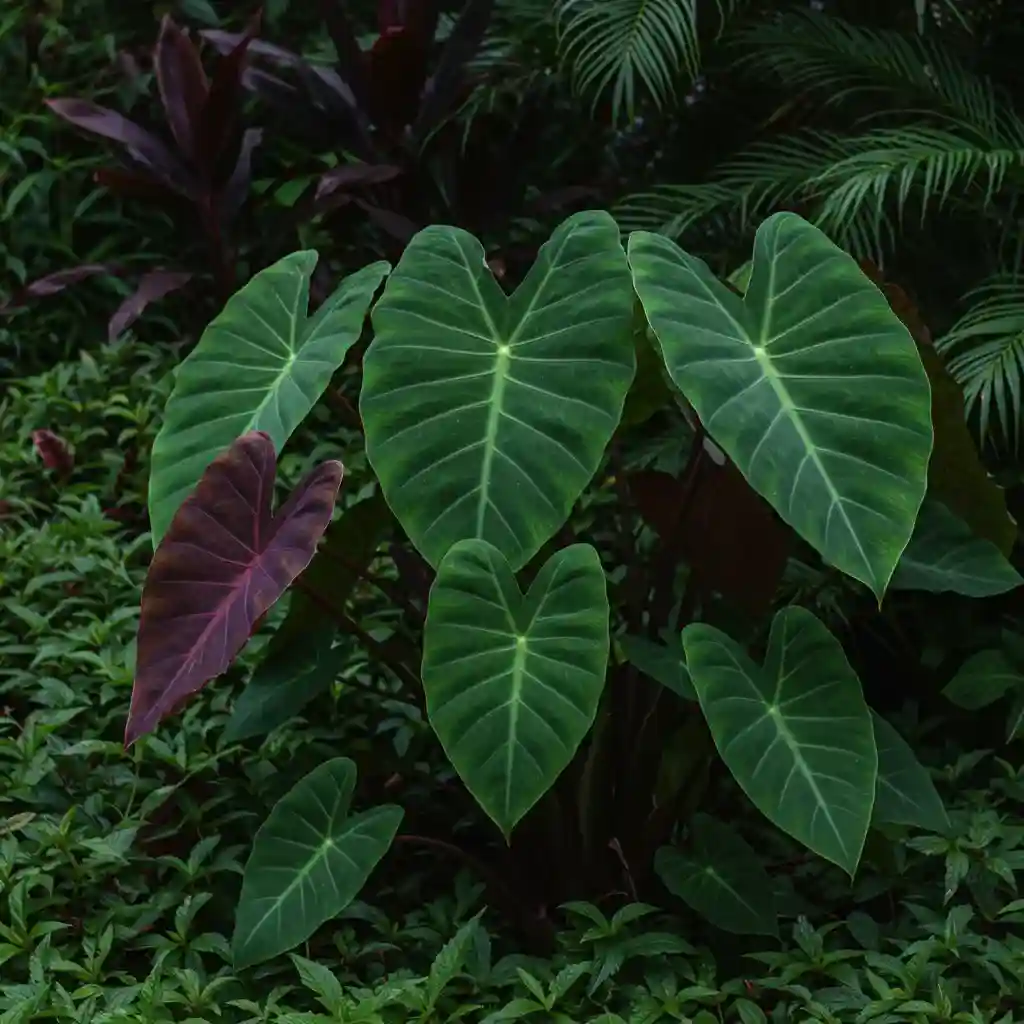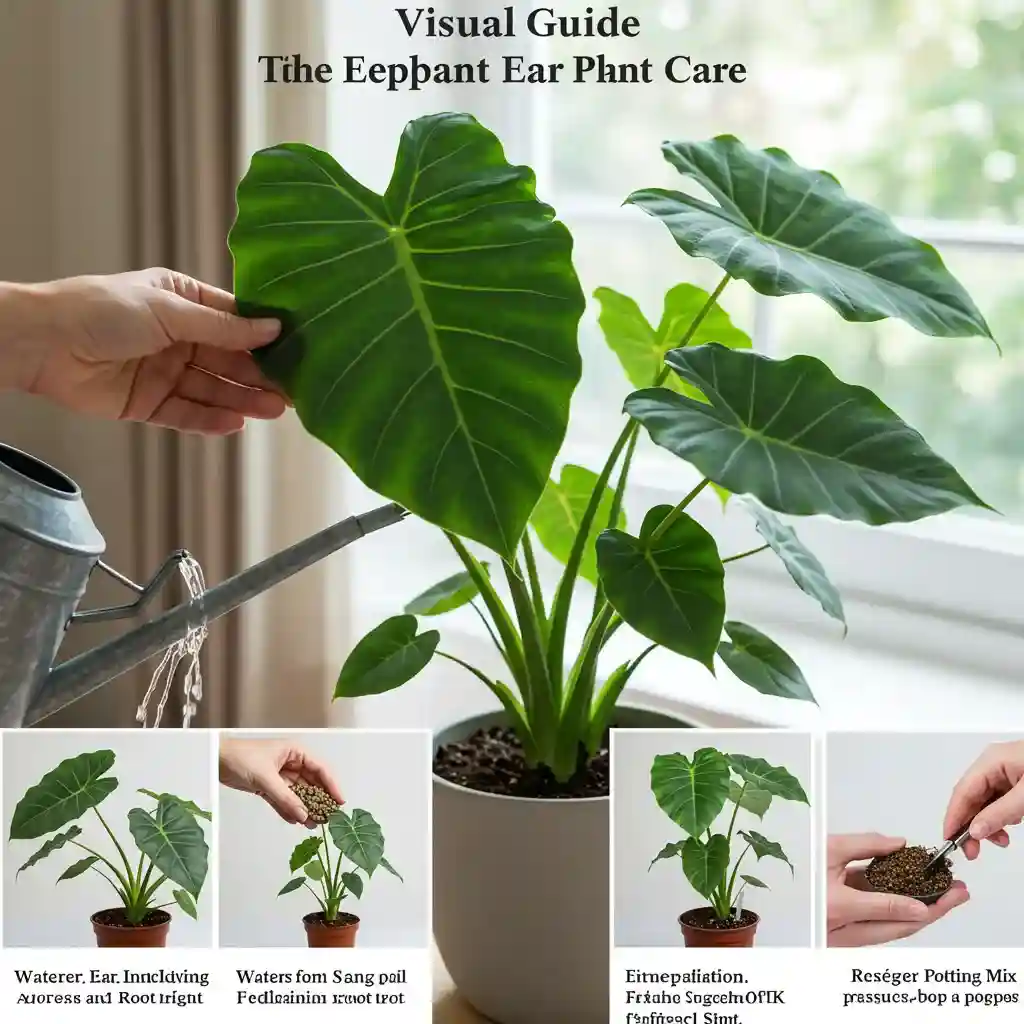EElephant ear plants (Colocasia, Alocasia, and Xanthosoma species) are prized for their dramatic, oversized leaves, but proper elephant ear plant care is essential to keep them thriving. These tropical beauties can transform any garden or indoor space into a lush paradise—if given the right light, water, and humidity.
In this comprehensive guide, we’ll cover everything you need to know about elephant ear plant care, including light requirements, watering needs, soil preferences, fertilization, pest control, and overwintering tips. Whether you’re growing the classic green variety, the dark and mysterious ‘Black Magic’ elephant ear plant, or another cultivar, these expert tips will help your plant flourish.
Key Takeaways
-
Light: Prefers bright, indirect light but tolerates partial shade.
-
Watering: Needs consistently moist soil—never let it dry out completely.
-
Humidity: Thrives in high humidity (above 60%).
-
Soil: Requires rich, well-draining soil with organic matter.
-
Fertilization: Benefits from a balanced fertilizer every 4–6 weeks during the growing season.
-
Winter Care: In cold climates, tubers must be dug up and stored indoors.
-
Pests: Watch for spider mites, aphids, and fungal diseases.
Elephant Ear Plant Care Guide
1. Light Requirements for Optimal Growth
Elephant ear plants originate from tropical regions where they grow under the canopy of larger trees, receiving dappled sunlight. Mimicking these conditions will help your plant thrive.
-
Outdoor Plants:
-
Ideal: Morning sun with afternoon shade.
-
Tolerates: Full shade, but growth may slow.
-
Avoid: Harsh midday sun, which can scorch leaves.
-
-
Indoor Plants:
-
Place near an east or west-facing window for bright, indirect light.
-
If natural light is insufficient, supplement with grow lights.
-
-
Special Note for ‘Black Magic’ Elephant Ear:
-
This variety can tolerate more shade but needs some light to maintain its deep purple-black foliage.
-
2. Watering: Keeping the Soil Consistently Moist

Elephant ears are water-loving plants and will suffer if the soil dries out. However, overwatering can lead to root rot, so balance is key.
-
Growing Season (Spring-Summer):
-
Water 2–3 times per week, ensuring the soil stays evenly moist.
-
Check the top 1–2 inches of soil—if dry, it’s time to water.
-
-
Dormant Season (Fall-Winter):
-
Reduce watering frequency, allowing the soil to dry slightly between waterings.
-
Indoor plants may still need weekly watering if kept in a warm environment.
-
-
Signs of Improper Watering:
-
Overwatering: Yellowing leaves, mushy stems, root rot.
-
Underwatering: Drooping leaves, crispy edges, stunted growth.
-
3. Choosing the Right Soil Mix
These plants need nutrient-rich, well-draining soil to prevent waterlogging while retaining enough moisture.
-
Best Soil Composition:
-
50% peat moss or coco coir (retains moisture).
-
30% perlite or sand (improves drainage).
-
20% compost or worm castings (adds nutrients).
-
-
For Potted Plants:
-
Always use a pot with drainage holes.
-
A layer of gravel at the bottom can help prevent clogging.
-
-
Soil pH:
-
Slightly acidic to neutral (5.5–7.0) is ideal.
-
4. Temperature & Humidity Preferences
Since elephant ears are tropical plants, they thrive in warm, humid environments.
-
Ideal Temperature Range:
-
65°F–85°F (18°C–29°C) for optimal growth.
-
Below 50°F (10°C): Growth slows, and leaves may die back.
-
Frost: Will kill the foliage; tubers must be stored indoors.
-
-
Humidity Requirements:
-
Above 60% humidity is best.
-
For Indoor Plants:
-
Use a humidity tray or room humidifier.
-
Mist leaves 2–3 times per week.
-
Group with other plants to create a microclimate.
-
-
5. Fertilizing for Lush, Vibrant Leaves

Elephant ears are heavy feeders and benefit from regular fertilization during their active growing season.
-
Best Fertilizer Types:
-
Balanced liquid fertilizer (10-10-10 or 20-20-20) every 4–6 weeks.
-
Slow-release granular fertilizer mixed into the soil at planting.
-
Organic options: Compost tea, fish emulsion, or worm castings.
-
-
Avoid Over-Fertilizing:
-
Too much fertilizer can cause leaf burn (brown edges).
-
Flush soil occasionally to prevent salt buildup.
-
6. Pruning & General Maintenance
Regular pruning keeps your elephant ear plant healthy and encourages new growth.
-
When to Prune:
-
Remove yellow, damaged, or dying leaves as needed.
-
Cut back foliage before winter dormancy (outdoor plants).
-
-
Cleaning Leaves:
-
Wipe leaves with a damp cloth to remove dust.
-
Helps improve photosynthesis and pest resistance.
-
7. Common Pests & Diseases
While generally hardy, elephant ears can face a few issues:
-
Spider Mites:
-
Signs: Tiny webs, yellow speckling on leaves.
-
Treatment: Spray with neem oil or insecticidal soap.
-
-
Aphids:
-
Signs: Sticky residue, curled leaves.
-
Treatment: Blast off with water or use ladybugs as natural predators.
-
-
Fungal Leaf Spot:
-
Signs: Brown/black spots with yellow halos.
-
Prevention: Avoid overhead watering, improve air circulation.
-
8. Overwintering Elephant Ear Plants

In USDA Zones 7 and below, elephant ear tubers must be dug up and stored indoors to survive winter.
Step-by-Step Winter Storage:
-
After First Frost:
-
Cut back all foliage to 2–3 inches above the soil.
-
-
Dig Up Tubers:
-
Carefully lift tubers with a garden fork.
-
-
Dry & Clean:
-
Let tubers dry in a shaded area for 1–2 days.
-
Brush off excess soil (do not wash).
-
-
Storage:
-
Pack tubers in peat moss, sawdust, or vermiculite.
-
Store in a cool, dark place (45–55°F) like a basement or garage.
-
-
Replanting in Spring:
-
Plant tubers after the last frost when soil warms to at least 65°F.
-
9. Propagating Elephant Ear Plants
Want more plants? Elephant ears can be easily propagated by dividing tubers.
-
Best Time: Early spring before new growth starts.
-
Method:
-
Dig up the plant and gently separate tubers, ensuring each has at least one growth node (eye).
-
Replant divisions in fresh soil, water well, and keep warm.
-
-
Growth Timeline:
-
New shoots should appear in 2–4 weeks.
-
10. Do Elephant Ear Plants Flower?
While primarily grown for their foliage, some varieties (like Colocasia) produce small, calla lily-like flowers. However, these blooms are usually hidden under the leaves and are not the main attraction.
Final Thoughts
With the right elephant ear plant care, these tropical giants can become the centerpiece of your garden or indoor jungle. By providing ample moisture, warmth, and nutrients, you’ll enjoy their spectacular foliage year after year. Whether you’re a beginner or an experienced gardener, these tips will help you grow healthy, vibrant elephant ears with ease.
Ready to start? Pick up an elephant ear plant and watch it transform your space into a tropical paradise!
FAQs About Elephant Ear Plant Care
How often should I water my elephant ear plant?
Water 2–3 times per week in summer, ensuring the soil stays evenly moist. Reduce to once a week in winter when growth slows.
Can elephant ears grow indoors?
Yes! Provide bright indirect light, high humidity (60%+), and consistent moisture. Avoid cold drafts near windows.
Why are my elephant ear leaves turning yellow?
Common causes include overwatering, poor drainage, nutrient deficiency, or natural leaf aging. Trim yellow leaves to redirect energy.
Is the elephant ear plant toxic?
Yes. All parts contain calcium oxalate crystals, which can irritate skin and are toxic if ingested by pets or humans.
How fast do elephant ear plants grow?
In warm, humid conditions, they can grow 3–5 feet tall in a single growing season.
Can I grow elephant ears in full sun?
Most varieties prefer bright indirect light, but some (like Colocasia esculenta) tolerate full sun if soil moisture is maintained.
Why are my elephant ear leaves small?
Small leaves often indicate insufficient light, low humidity, or lack of fertilizer. Move to a brighter spot and feed monthly.
How do I revive a drooping elephant ear plant?
Drooping usually signals underwatering or low humidity. Soak the soil thoroughly and mist leaves.
Can I grow elephant ears in water?
Yes! They thrive in shallow water gardens or ponds as long as tubers are partially submerged.
Do elephant ears attract pests?
They can attract spider mites, aphids, or mealybugs, especially indoors. Treat early with neem oil or insecticidal soap.
Should I mist my elephant ear plant?
Yes! Misting 2–3 times a week boosts humidity, mimicking their tropical habitat.
When should I repot my elephant ear?
Repot every 1–2 years in spring if roots outgrow the container. Use fresh, well-draining soil.
Can I use Miracle-Gro for elephant ears?
Yes. A balanced liquid fertilizer like Miracle-Gro (10-10-10) works well. Apply every 4–6 weeks in growing season.
Why are the edges of my elephant ear leaves turning brown?
Brown edges often result from low humidity, fluoride in tap water, or salt buildup. Use filtered water and increase humidity.
Can I plant elephant ears in the ground?
Absolutely! Plant tubers 1–2 inches deep in spring after frost risk passes. They thrive in garden beds with rich soil.
How do I know if my elephant ear is dormant?
Dormancy signs include yellowing leaves and halted growth in fall/winter. Reduce watering and wait for spring regrowth.
Can I propagate elephant ears from cuttings?
No. They’re propagated via tuber division (separating offsets from the parent plant).
Are coffee grounds good for elephant ears?
Yes! Coffee grounds add acidity and organic matter to soil. Mix sparingly into compost to avoid mold.
Do elephant ears need a lot of space?
Yes. Space plants 3–6 feet apart outdoors to accommodate their large spread.
What’s the best time to plant elephant ear bulbs?
Plant tubers in spring once soil temperatures reach 65°F (18°C) for optimal germination.

